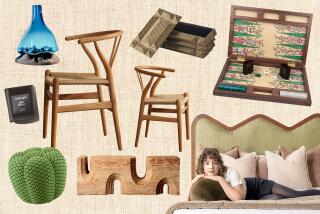Move Over, Martha!
- Share via
In this corner, weighing in at 12 ounces, with 96 pages and a price of $4.95: dwell magazine, subtitled At Home in the Modern World. And in this corner: One, subtitled Design Matters, weighing in at 1 pound, 7 ounces, with 192 pages and a price of $4.95.
As if newsstand shelves aren’t groaning already under the strain of countless shelter/design/architecture magazines, here come two more to slug it out among the competition. Similarities first: Both have modern leanings; both angle toward that golden demographic of 25- to 40-year-old hip, wired, design-savvy, city-dwelling consumers; both are published in San Francisco, both have Web sites. Differences: dwell (yes, that’s with a small “d”), a bimonthly that premiered last August, focuses on interior design and architecture, presenting spaces as people actually live and work in them, not as super-pristine aspirational vignettes that are the bread and butter of most shelter mags. One, a bimonthly that premiered in December, takes the view that design is in practically everything we see and touch, and offers a blue-plate special of cutting-edge products, graphics, interior design, architecture and fashion. Dwell’s graphics are low-key and clean; One is in your face, colorful, loud, all over the place.
Both publications are based on the belief that while design isn’t the only thing, it’s important to people’s lives. That philosophy is shared by many in the design world these days, including David Walker, director of special programs for Pasadena’s Art Center College of Design, who says, “I don’t think there’s any zeitgeist going on in music right now. It’s a very flat time. I think there are more interesting things happening in the design world. I think the iMac is more exciting than Britney Spears.”
It took refurbishing a “rundown shack” in Mill Valley, Calif., for dwell publisher and founder Lara Hedberg Deam to realize there was no design magazine that addressed her needs: “One night I was looking through a foreign design magazine, and I thought if there was only something more rigorous than a consumer magazine, but not out of reach for the person I was when I started building my home, something that would help me in the process. That was the switch that turned on for me.”
With a background in direct mail, nonprofits and retail, Deam decided there was a niche in the shelter magazine market that wasn’t being addressed. “You get sort of a sick feeling in your stomach sometimes looking at these magazines,” she says, laughing. “I think they don’t get at the true experience that most people have with their homes. I really believe it’s important to grapple with issues such as how you really want to live. It’s my hope that this magazine can pose more questions than it even answers.”
Issues are themed; the current one is “Come Home to the Future,” exploring the reality of how people will live as the new millennium progresses, but without envisioning a techno-wonderland of sleek steel cyber-friendly appliances. Stories include a Pasadena hillside home by architects Frank Escher and Ravi GuneWardena that seems to float above the landscape; a rethinking of Houston’s deep, narrow shotgun houses as viable dwellings; and how one architect interpreted a retirement home for his parents.
This new entry into the market has been met with some dissent; dwell editor in chief Karrie Jacobs acknowledges that some architects and interior designers prefer seeing their work in a more idealized presentation, as opposed to the magazine’s play-it-as-it-lays approach.
One has taken its drubbings, too, for trying to cover so much ground that it might appear to lack focus and a point of view. Editor in chief Stacy Morrison was prepared for that; she’s been involved with several magazine launches (she was managing editor of Conde Nast’s Women’s Sports & Fitness and was editor in chief at Modern Bride when it relaunched in 1998) and knows it takes time to find one’s voice.
“We’re looking to find what the tolerances are of our audience,” she says, “where they hit on the knowledge base, and then we’ll find out what’s going to be turned up and turned down. We’re trying to let people know what’s cool without being too cool. That’s a real challenge.”
Stories range from a profile of product/furniture designer Karim Rashid (he of the sensuous Garbo trash can for Umbra), an anatomy of the Kobe Bryant Adidas sneaker, a look at a modern baseball stadium and a fashion layout featuring body-baring evening-wear.
This inclusive approach to design was “absolutely intentional,” says Morrison. “Design conjures up things that are high-minded and inaccessible, but we’re telling people it’s already in your life, it’s not something you have to learn. The tripod the magazine stands on is home, fashion and technology, and that’s what makes us different from shelter magazines.”
Working in both of these magazines’ favor is a societal interest in and attention to design, the likes of which previous generations haven’t seen. With Home and Garden Television on its third network and a democratization of design that finds uber-stylemeisters Philippe Starck and Michael Graves creating products for Target stores, no one can argue that design is a passing fancy.
But can dwell and One find a sustainable audience among heavyweights such as Architectural Digest, Home & Garden, Elle Decor and even Martha Stewart Living? The pie has already been carved up pretty well, with magazines like Nest and Wallpaper luring the design cognoscenti corps, Real Simple reeling in the pare-it-downers and Metropolitan Home attracting moneyed urbanites.
Yes, says Brooke Hodge, the recently arrived curator of architecture and design at L.A.’s Museum of Contemporary Art. “Design is part of everyone’s life. This age group, this demographic especially is always looking for ideas. Whether they’re getting their first apartment or home, they’re looking for hip ways to furnish it.”
Says Art Center’s David Walker, “I think that people are taking much more control in designing their lives, and I definitely think these publications act as a stimulus and help people achieve their goals.”










